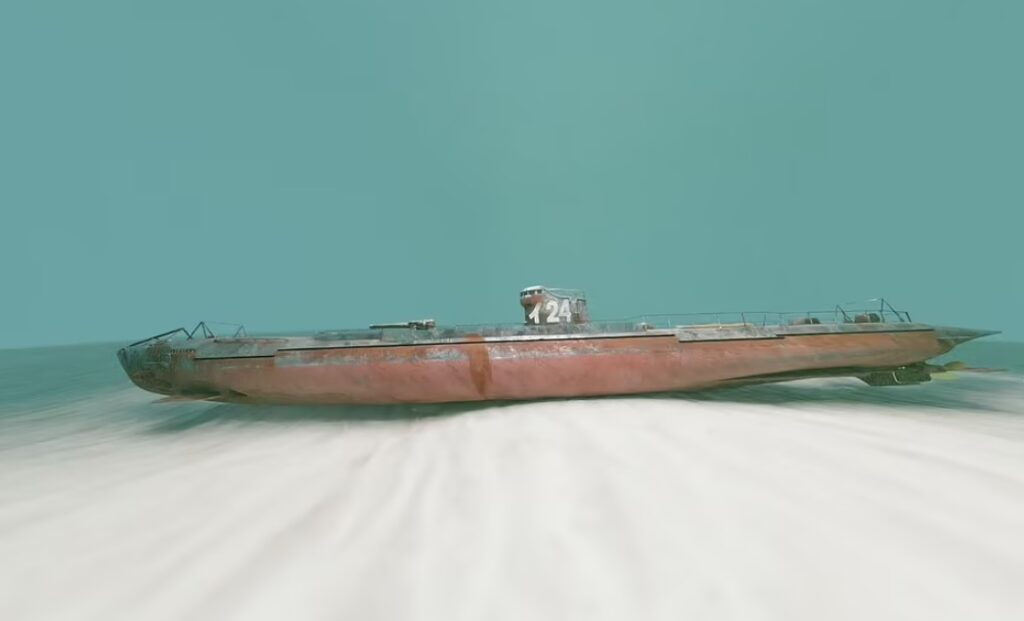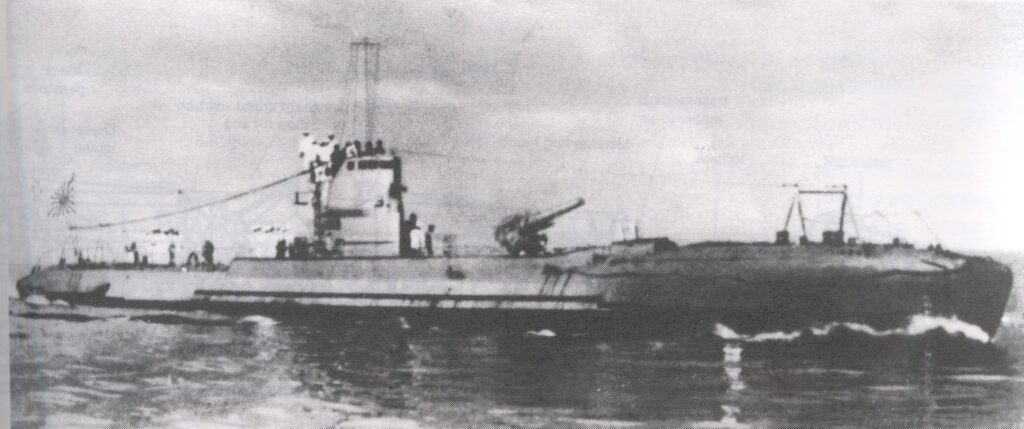
Japanese Submarine and 80-man Crew Still Entombed
● A Japanese submarine is reported to have sunk 40 miles off the coast of Darwin Harbour back in 1942. A total of 80 sailors died on board.
● HMAS Deloraine sank the Japanese submarine during the anti-shipping operations of the Australian Navy.
● People can virtually access the wreck through modern-day virtual reality using innovative technology.
● Advanced virtual reality technology enables people to travel over a Japanese World War Two submarine.
I-124, initially named Submarine Minelayer No. 52, was a Japanese navy submarine.
On January 20, 1942, the Australian ship HMAS Deloraine sank the submarine. As a result, the crew of 80 sailors died. The wreckage has sat on the sea bed ever since.
War Grave
The site is inaccessible for exploration as the heritage is shared between both Japan and Australia. The submarine wreck is also under the protection of Commonwealth legislation. Diving near the protected site is controlled, making the site out of reach to the wider public as it is classed as a war grave.
 Dr McCarthy said developments in virtual technology are making it possible to finally explore wrecks and submerged landscapes previously hidden to the wider public Credit: Flinder University
Dr McCarthy said developments in virtual technology are making it possible to finally explore wrecks and submerged landscapes previously hidden to the wider public Credit: Flinder University
Former Japanese Prime Minister, Shinzo Abe, attended a memorial event back in 2018 in Darwin to honour the deceased Japanese sailors.
In October 2021, the Australian Institute of Marine Science and the Northern Territory Government Heritage Branch launched a research project to map the wreckage using modern hi-tech sensing equipment for their research program.
Expert maritime archaeologist, Dr. John McCarthy, collected the data and worked on the project to create an exclusive virtual reality experience.
‘Drawing on our data, and historic ship plans and photographs, we’ve created a virtual dive experience in which the video takes the viewer through the data gathering process, and then takes you down into the deep, to experience the wreck firsthand,’ said Dr McCarthy.
‘The archaeological survey shows that the wreck is in good condition, but with some signs of degradation of the outer hull that require further investigation.
‘Our aim was to create a realistic virtual experience with an accurate digital reconstruction of the submarine given the historical significance of the wreck in Australia and Japan.’
Virtual reality
According to Dr. McCarthy, people can explore the submarine using a VR headset and “experience the wreck first-hand.” There is some degradation, yet the vessel remains in remarkably good condition even after 80 years.
The ship that sunk the submarine, HMAS Deloraine, was one of the Bathurst-class corvettes commissioned by the Royal Australian Navy during World War Two. The Japanese submarine, I-124, was built in Japan in 1926 by the Kawasaki Corporation so was, in comparison, somewhat dated even by World War Two. ‘We’ve created a virtual dive experience in which the video takes the viewer through the data gathering process, and then takes you down into the deep, to experience the wreck firsthand,’ said Dr McCarthy. Photo Credit: Flinder University
‘We’ve created a virtual dive experience in which the video takes the viewer through the data gathering process, and then takes you down into the deep, to experience the wreck firsthand,’ said Dr McCarthy. Photo Credit: Flinder University
The submarine was laying mines off the coast in the northern territory of Australia. When the Japanese attacked Darwin, Australian Navy corvettes, including HMAS Deloraine, headed for port. However, I-124 initiated an attack and fired a torpedo but missed. HMAS Deloraine took her chance and didn’t!
Sank
In the conflict, the Australian Navy attacked the submarine using depth charges. These anti-submarine weapons are dropped and detonated near the target and carried a high success rate. I-124 was one such victim.
The first charge led to oil and air bubbles on top of the surface, but the Japanese attacks continued. HMAS Lithgow and HMAS Katoomba also joined the conflict and attacked the submarine. All 80 crew members onboard I-124 died when the submarine was sunk on January 20, 1942
All 80 crew members onboard I-124 died when the submarine was sunk on January 20, 1942
The Australian Navy claimed to have hit more than one target, but I-124 was the only submarine present on the battle scene. The damaged Japanese submarine sank to the bottom of the sea. Consequently, all 80 men present on board were killed.
Japanese Submarine
It was the first Japanese submarine destroyed by the Royal Australian Navy, and the fourth Japanese submarine sank during World War Two.
The news was confirmed on January 26, 1942, when U.S Navy divers inspected the scene and found the submerged sub. The depth charge reportedly blew over the submarine’s hatch. Experts identified the location of the wreckage as 12°03′S 130°09′E.
The divers allegedly removed the naval code books from the submarine, but Dr. McCarthy disproves the theory.
Dr. Tom Lewis also published a book named, ‘Darwin’s Submarine I-124: The Story of a Covert Japanese Squadron Waging a Secret Underwater War against Northern Australia.’
Three months after the incident, on April 30, 1942, Japanese officials struck down I-124 from the Navy list.
In the 1950s the daughter of the sub’s commander, Atsuko Kishigami, began a campaign to have the submarine raised and its entombed bodies returned to Japan. The Japanese Fujita Salvage Company, then in Darwin salvaging the wrecks of ships still lying in the harbour, made a brief investigation into the proposal, before it was decided the costs were prohibitive.
Dr Tom Lewis
Japan was one of Australia’s significant rivals during World War Two. A month later, following the submarine incident, the Bombing of Darwin occurred on February 19, 1942. Also known as the Battle of Darwin, it was the biggest single attack on Australia engineered by a foreign power.
About 188 Japanese planes are reported to have conducted two raids on Darwin, killing approximately 243 people and leaving between 300-400 wounded. It is also noteworthy that Darwin was attacked 64 times up until November 1943.
The new virtual dive experience is available on YouTube in both English and Japanese.
On December 5, 1976, the Historic Shipwrecks Act was enacted in Australia to legally protect shipwrecks and war relics. I-124 was placed under the protection of the legislation. In July 1977, an exclusive zone was also established around the area.
News
The Hanging Temple: China’s 1,500-Year-Old Cliffside Marvel of Faith and Engineering
The Hanging Temple: China’s 1,500-Year-Old Cliffside Marvel of Faith and Engineering Perched precariously on the cliffs of Mount Heng in Shanxi Province, China, the Hanging Temple, also known as Xuankong Temple, Hengshan Hanging Temple, or Hanging Monastery, is an architectural…
The Willendorf Venus: A 30,000-Year-Old Masterpiece Reveals Astonishing Secrets
The Willendorf Venus: A 30,000-Year-Old Masterpiece Reveals Astonishing Secrets The “Willendorf Venus” stands as one of the most revered archaeological treasures from the Upper Paleolithic era. Discovered in 1908 by scientist Johann Veran near Willendorf, Austria, this small yet profound…
Unveiling the Maya: Hallucinogens and Rituals Beneath the Yucatán Ball Courts
Unveiling the Maya: Hallucinogens and Rituals Beneath the Yucatán Ball Courts New archaeological research has uncovered intriguing insights into the ritual practices of the ancient Maya civilization. The focus of this study is a ceremonial offering found beneath the sediment…
Uncovering the Oldest Agricultural Machine: The Threshing Sledge’s Neolithic Origins
Uncovering the Oldest Agricultural Machine: The Threshing Sledge’s Neolithic Origins The history of agricultural innovation is a fascinating journey that spans thousands of years, and one of the earliest known agricultural machines is the threshing sledge. Recently, a groundbreaking study…
Nara’s Ancient Sword: A 1,600-Year-Old Protector Against Evil Spirits
Nara’s Ancient Sword: A 1,600-Year-Old Protector Against Evil Spirits In a remarkable discovery that has captured the attention of archaeologists and historians alike, a 7.5-foot-long iron sword was unearthed from a 1,600-year-old burial mound in Nara, Japan. This oversized weapon,…
The Inflatable Plane, Dropped Behind the Lines for Downed Pilots
Experimental The Inflatable Plane, Dropped Behind the Lines for Downed Pilots The Inflatoplane from Goodyear was an unconventional aircraft developed by the Goodyear Aircraft Company, a branch of the renowned Goodyear Tire and Rubber Company, also famed for the Goodyear…
End of content
No more pages to load











